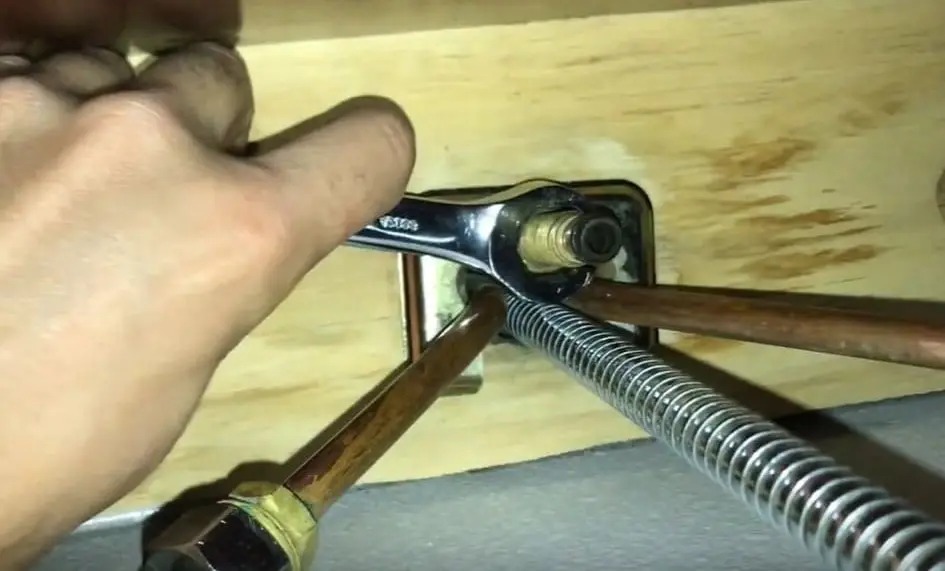When a kitchen faucet nut under sink is tight, it means that the nut has been securely tightened in place. This means that the faucet is securely attached to the sink and there should be no leaks or wobbling. A tight faucet nut will ensure that the faucet is stable and secure and that it will not come loose over time.
Thank you for reading this post, don't forget to subscribe!
To achieve a tight faucet nut you should use a wrench to turn the nut clockwise until it is snug and secure, but be careful not to over-tighten it as it may cause damage to the faucet or the sink.
What Tool do you use to Tighten kitchen Faucet Nuts?
A basin wrench or a socket wrench can be used to tighten kitchen faucet nuts.
Why is my kitchen Faucet Nut Loose?
There are several possible reasons why a kitchen faucet nut under the sink may become loose:
Wear and tear:
Over time, the nut may become loose due to normal wear and tear. This is especially true if the faucet is frequently used.
Improper installation:
If the faucet was not installed properly, the nut may not have been tightened sufficiently, resulting in a loose connection.
Vibrations from the pipes:
Pipes in the wall or under the sink can vibrate, causing the nut to become loose over time.
Corrosion:
Corrosion can occur on the threads of the nut, making it difficult to tighten securely.
Temperature changes:
With temperature changes, the metal may expand and contract which can cause the nut to become loose.
It is important to check and tighten the nut if it is loose to prevent leaks and damage to the sink and cabinet. If the problem persist after you’ve tightened the nut, it may be necessary to replace the faucet or the nut
6 Steps to Tighten kitchen Faucet Nut Under Sink

To tighten a kitchen faucet nut under the sink, you will need to follow these steps:
- Turn off the water supply valves under the sink. This will prevent any water from flowing while you are working on the faucet.
- Place a towel or bucket under the sink to catch any water that may leak out. This will help to protect your floors and cabinets from water damage.
- Locate the nut that is loose. It is typically located between the faucet and the sink.
- Use adjustable pliers or a basin wrench to grip and turn the nut clockwise to tighten it. The pliers or wrench will help you to get a better grip on the nut, making it easier to turn.
- Once the nut is tight, turn the water supply valves back on and check for any leaks. If there are any leaks, you may need to tighten the nut further or make other adjustments to the faucet.
- Finally, it is a good practice to check the installation instructions that came with your faucet as the process may vary depending on the faucet model.
It is important to make sure the water supply valves are off, and you have a towel or bucket to catch any water that may leak out before you start working on the faucet to prevent any damage or injury.
You May Also Interested:
- How to Tighten Loose kitchen Faucet
- How to Increase Water Pressure in kitchen Sink
- How to Unclog a Double kitchen Sink with Standing water
- How to Unclog a Double kitchen sink
FREQUENTLY ASKED QUESTIONS
How do I turn off the water supply valves under the sink?:
The water supply valves are typically located under the sink, close to the faucet. They can be turned off by rotating them clockwise or by using a flathead screwdriver to turn them off. It is important to do this step before tightening the faucet nut to prevent water from flowing while you are working on the faucet.
Can I use pliers instead of a basin wrench to tighten the faucet nut?
Yes, adjustable pliers can be used to grip and turn the nut clockwise to tighten it, but a basin wrench is specifically designed to reach tight spaces, it is easier to use and will give you a better grip on the nut.
Should I check the installation instructions for my specific faucet model before tightening the nut?
Yes, it is a good practice to check the installation instructions that came with your faucet as the process may vary depending on the faucet model.
How do I know if I have a loose kitchen faucet nut?
A loose kitchen faucet nut can cause a leak around the base of the faucet. If you notice a leak or hear a dripping sound coming from under the sink, it is likely that you have a loose kitchen faucet nut.
Can I tighten a kitchen faucet nut myself or do I need a professional?
Tightening a kitchen faucet nut is a relatively simple task that can be done by most homeowners. However, if you are unsure of how to properly tighten the nut or if the problem persists after tightening, it may be best to consult a professional plumber for assistance.
CONCLUSION
Learning basic plumbing skills, such as tightening a kitchen faucet nut under the sink, can be beneficial even if you typically hire commercial plumbers. This knowledge can come in handy in emergency situations where immediate action is required and professional help is not readily available. This article aims to provide you with the information necessary to handle such scenarios.

